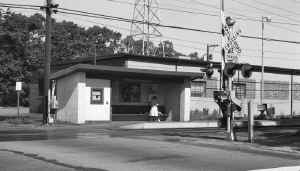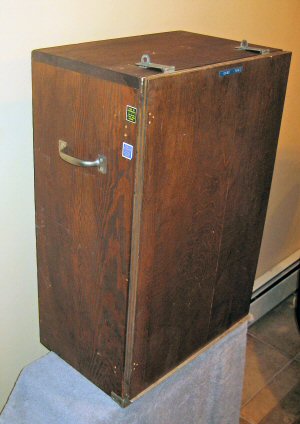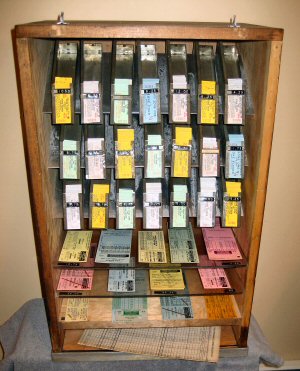|
Reminiscences as
an Extra Ticket Clerk
Part
1 by Dave Keller
During
the summer of 1972
when I was an extra ticket clerk, I once worked the East Rockaway
station. It was a “newer” and smaller building on the east
side of the tracks. It was only open for ticket sales for several
morning hours on Mondays to sell commutation tickets.
I
had to drive to Lynbrook station and pick up a “portable ticket
office” (A heavy, cumbersome, wooden box filled with ticket stock,
dater and cast
metal dater die, rubber stamps, etc. and a large padlock on the outside
of the box, all weighing in at around 50 pounds) then take the train
down to East Rockaway. Then, get off the train, and lug the box
down the platform, over the crossing and back down the other platform to
get to the station.
I
had less of a walk going back.
Had
to do the same thing for
Merillon Avenue
, only picked up my stock box at
Mineola
and had to drive to
Merillon Ave.
station. There
were several other stations that had a temporary agency; Albertson was
one; Hunterspoint Avenue
was another one.

Albertson
Shelter and Monday morning-only ticket window. View NW 6/1987
Photo/Archive: Dave Keller
This
is an example of the ticket case used:


Here’s
the inside of the case with ticket stock. There would be a
LOT
of commutation ticket pads (weekly and monthly tickets) and the dater
die and rubber stamps would be stuffed in whatever cubby hole had room.
This case is believed to have been the extra ticket case that was used
on Friday afternoons at
Hunterspoint Avenue
in
L.
I.
City
. (Both photos courtesy of
David M. Morrison).
Back to Merillon Ave.; unfortunately
there were no
toilet facilities at either Merillon Ave.
or East Rockaway and it smelled accordingly. I
walked across the parking lot to a 7-11, bought a large coffee and after
drinking it, used the cup to recycle
my morning coffee.
I
was kind enough to leave it for the next clerk. I wrote across the
top of the cup “
Merillon Avenue
toilet facilities.” I then used a ticket punch and punched some
holes about 1 inch down from the top. Next to the holes I wrote
“overflow level.” Hey!
I had to do SOMETHING between trains! ;-)
Reminiscences as an Extra Ticket Clerk
Part
2 by Dave Keller
I trained as a summer
extra ticket clerk in the old baggage room at the west end of the Garden
City depot. Basic training classes were held there for several days and
after the class training was over, I was sent out for “on-the-job”
training, called “posting.” I was “posted” to the Farmingdale station
under the head ticket clerk there whose name was Barbara Stillwagon.
There, under her supervision, I worked for about a week selling tickets,
doing daily remittances and performing the other duties of a ticket
clerk.
After that week of
“posting” was over, I was on my own. I had to “shape up” daily, which
meant I had to call in every day to see where I was to work the next
day. Clerks who didn’t call in regularly were usually not given work.
Those who were diligent about calling in were sure to work every day. I
kept a daily diary of each place I worked, noting anything interesting,
unusual situations with customers, etc. and stamped the front of each
page with the station’s dater-die, which was the identifying imprinter
that a ticket clerk used to stamp on the back of each ticket sold, and
on remittance sheets.
Each dater die
identified your station, your ticket clerk number at that station and
the date. It was placed in the bottom of the dater-die machine, under
the inked ribbon, so, when one slid the ticket, face-up, under the
hammer portion, and smacked the top handle with their hand, the
dater-die would come in contact with the inked ribbon and the back of
the ticket being sold. Unlike a rubber stamp, these dies were made of
brass.
Beside my training at
Farmingdale, I worked Merillon Avenue, East Rockaway (both mentioned in
“Part 1”), Far Rockaway (Nameoke Avenue), Valley Stream, Syosset, Long
Beach, Bay Shore, Penn Station, Flatbush Avenue and Jamaica (when the
ticket windows were located along the north wall of the waiting room!).
I also worked the Travel Information Center located on one of the upper
floors of the general offices at Jamaica station and the Travel
Information Center at Penn Station.
The Travel Information
Center at Penn Station was nicknamed “the Fishbowl,” as you sat in a
small, glass-enclosed booth (very hot, no functioning air conditioning,
just a small fan), located directly across from the LIRR ticket
windows. People would line up and state their destination and you would
provide them with the next train departing time and track number. You
would also hand out timetables if requested. This was a very busy job!
The regular clerk there was a many-year veteran named Tommy Johnston,
who was also a railfan.
The Travel Information
Center at Jamaica answered train information requests via telephone.
You sat with a bank of other clerks with headsets, facing front (west),
with your supervisor sitting at an elevated desk behind you, keeping an
eye on you to be sure you were answering calls and not spending too much
time on each call. I worked the 2nd trick there several
times, knocking off with just enough time to charge downstairs to the
lobby, then back up the stairs to the under-track concourse and up the
final set of stairs to track 8 where I would get the last train out to
Patchogue with NO time to spare! Being cooped up in a room with no
windows, in a cubicle facing front, a boss on your back all the time and
having to ask permission to use the toilet provided me the incentive to
become a Special Services Attendant and actually see train service the
following summers!
When I worked Penn
Station, I worked a regular ticket window, but a couple of times I
worked the special Belmont Park window set up during racing season.
Special trains were run directly to the racetrack with no other stops
after Jamaica and no tickets punched or collected. Special Belmont Park
metal tokens were used and dropped by riders in turnstiles at the
racetrack. These were collected and re-used over and over again. My
job at that special window was to sell these tokens and what a bunch of
sales I would make! The older tokens had “Dashing Dan” on one side.
The newer ones had the MTA logo. Most of the race fans automatically
bought two tokens, representing a trip to the park and back. Some of
the “die-hards” only bought one, as they wanted to save ALL their
remaining money to bet on the horses (If I remember correctly, the fare
was $1.75 back then). I asked one “die-hard” what he would do if he
lost ALL his money. He said it would never happen. He had a system!!!
I could just visualize him using his “system” as he hustled people on
the Belmont Park station platform for the fare back after he lost
everything on “a sure thing.”
Dave Keller 08/06/2019
|